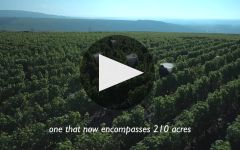Pascal Jolivet Sancerre Les Caillottes 2009
-
Wine
Spectator


Product Details
Your Rating
Somm Note
Winemaker Notes
A dry wine with balance and elegance on the palate. There's fresh, clean floral aromas and snappy, lip quenching acidity on the palate. This is a quite pleasant wine to sip and it pairs very well with seafood, fresh-water fish, white meats and soft cheeses.
Pair with shellfish, oysters, fish, crab, Asian cuisine.
Professional Ratings
-
Wine Spectator
This has the vintage’s rapier acidity, but it’s embedded in a creamy, porcelainlike texture that carries verbena, lemon curd, white peach and gooseberry notes through the long, stylish, stone-tinged finish. Drink now through 2013.
Other Vintages
2007-
Wine
Spectator
-
Wine
Enthusiast
-
Wine
Spectator
-
Wine
Spectator






The house of Pascal Jolivet is one of the youngest and most dynamic in the Loire Valley. Founded in 1985, this specialist in the wines of Sancerre and Pouilly-Fume has very quickly gained a leading position with the Michelin-starred restaurants of France. Pascal owns an estate of more than 40 acres evenly divided between two appellations.
He believes strongly in letting nature make the wine as much as possible, and seeks to tame the more aggressive qualities of the Sauvignon Blanc variety. His wines show the benefits of stainless steel vatting with naturally occurring yeasts. They are fermented cool rather than cold and are left of their lees for four to six months, gaining subtle but complex aromas as a result.
The Sancerre and Pouilly-Fume both originate from the Jolivet estate. The Sancerre is a composite of the three soil types in the district: calcareous clay, limestone, and flint. It is more flowery and subtle than many of its type. Pouilly-Fume, from the opposite bank of the Loire, comes from a large diversity of glacial soils and is normally more austere and minerally.

Capable of a vast array of styles, Sauvignon Blanc is a crisp, refreshing variety that equally reflects both terroir and varietal character. Though it can vary depending on where it is grown, a couple of commonalities always exist—namely, zesty acidity and intense aromatics. This variety is of French provenance. Somm Secret—Along with Cabernet Franc, Sauvignon Blanc is a proud parent of Cabernet Sauvignon. That green bell pepper aroma that all three varieties share is no coincidence—it comes from a high concentration of pyrazines (herbaceous aromatic compounds) inherent to each member of the family.

Marked by its charming hilltop village in the easternmost territory of the Loire, Sancerre is famous for its racy, vivacious, citrus-dominant Sauvignon blanc. Its enormous popularity in 1970s French bistros led to its success as the go-to restaurant white around the globe in the 1980s.
While the region claims a continental climate, noted for short, hot summers and long, cold winters, variations in topography—rolling hills and steep slopes from about 600 to 1,300 feet in elevation—with great soil variations, contribute the variations in character in Sancerre Sauvignon blancs.
In the western part of the appellation, clay and limestone soils with Kimmeridgean marne, especially in Chavignol, produce powerful wines. Moving closer to the actual town of Sancerre, soils are gravel and limestone, producing especially delicate wines. Flint (silex) soils close to the village produce particularly perfumed and age-worthy wines.
About ten percent of the wines claiming the Sancerre appellation name are fresh and light red wines made from Pinot noir and to a lesser extent, rosés. While not typically exported in large amounts, they are well-made and attract a loyal French following.
